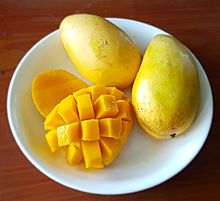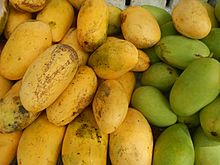Carabao (mango) facts for kids
Quick facts for kids Mangifera 'Carabao' |
|
|---|---|
 
|
|
| Genus | Mangifera |
| Cultivar | 'Carabao' |
| Marketing names | Carabao mango, Philippine mango, Manila mango, Manila super mango, Manggang kalabaw |
| Origin | Philippines |
The Carabao mango, also known as the Philippine mango or Manila mango, is a very sweet type of mango that comes from the Philippines. It is one of the most important mango types grown in the Philippines. People all over the world love it because of its sweetness and special taste. In 1995, the Guinness Book of World Records even listed it as the sweetest mango in the world!
This mango is named after the carabao, which is the national animal of the Philippines. A carabao is a type of water buffalo that is native to the Philippines.
Contents
What Makes Carabao Mangoes Special?
Carabao mangoes are usually about 12.5 centimeters (5 inches) long and 8.5 centimeters (3.3 inches) wide. They are shaped a bit like a kidney and can be short or long.
When a Carabao mango is ready to eat, it turns a bright yellow color, sometimes with a hint of green. Inside, the fruit has a rich yellow flesh that is soft and melts in your mouth. It also smells very nice!
Unlike some other mangoes, Carabao mangoes are polyembryonic. This means that one seed can grow into more than one plant. The best time to find fresh Carabao mangoes is usually from late May to early July.
Different Kinds of Carabao Mangoes
There are 14 different types, or strains, of Carabao mangoes. These strains have slightly different qualities. Some famous strains include:
- Talaban and Fresco from Guimaras
- MMSU Gold from the Ilocos Region
- Lamao and Sweet Elena from Zambales
In 2003, a study by the Department of Agriculture in the Philippines found that the Sweet Elena strain from Zambales was the sweetest Carabao mango of all!
How Carabao Mangoes Traveled the World
The Carabao mango also has a cool history of travel! Two types of mangoes grown in Mexico, called the Ataulfo and Manilita mango, actually came from the Philippine mango.
This happened a long time ago, between the 1600s and 1800s. Mangoes were carried across the Pacific Ocean on ships called Manila galleons. These ships sailed between the Philippines and Mexico. Because of this history, the Ataulfo and Manilita mangoes are sometimes called "Manila mangoes" in trade.
See also
 In Spanish: Mango Carabao para niños
In Spanish: Mango Carabao para niños

